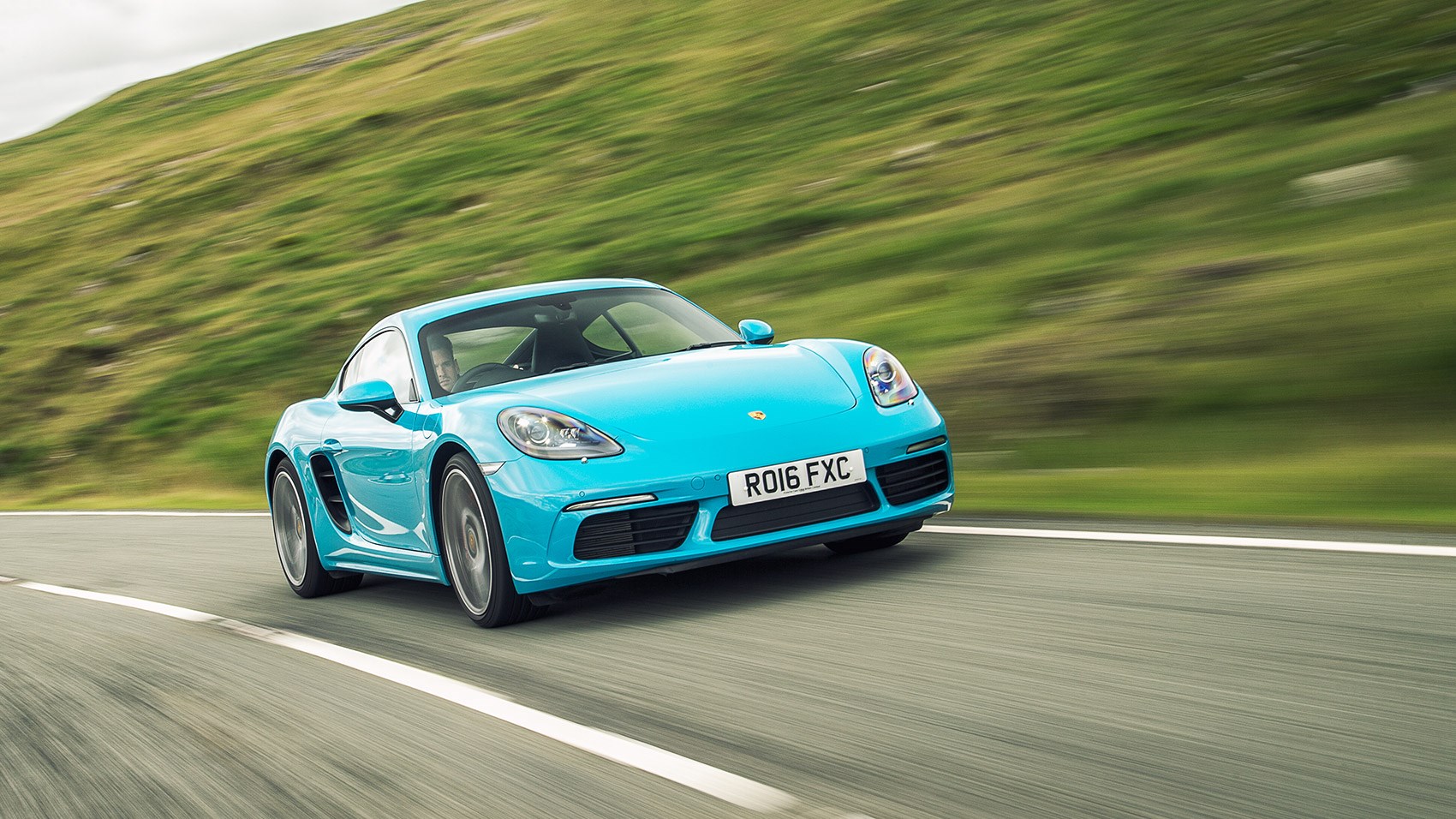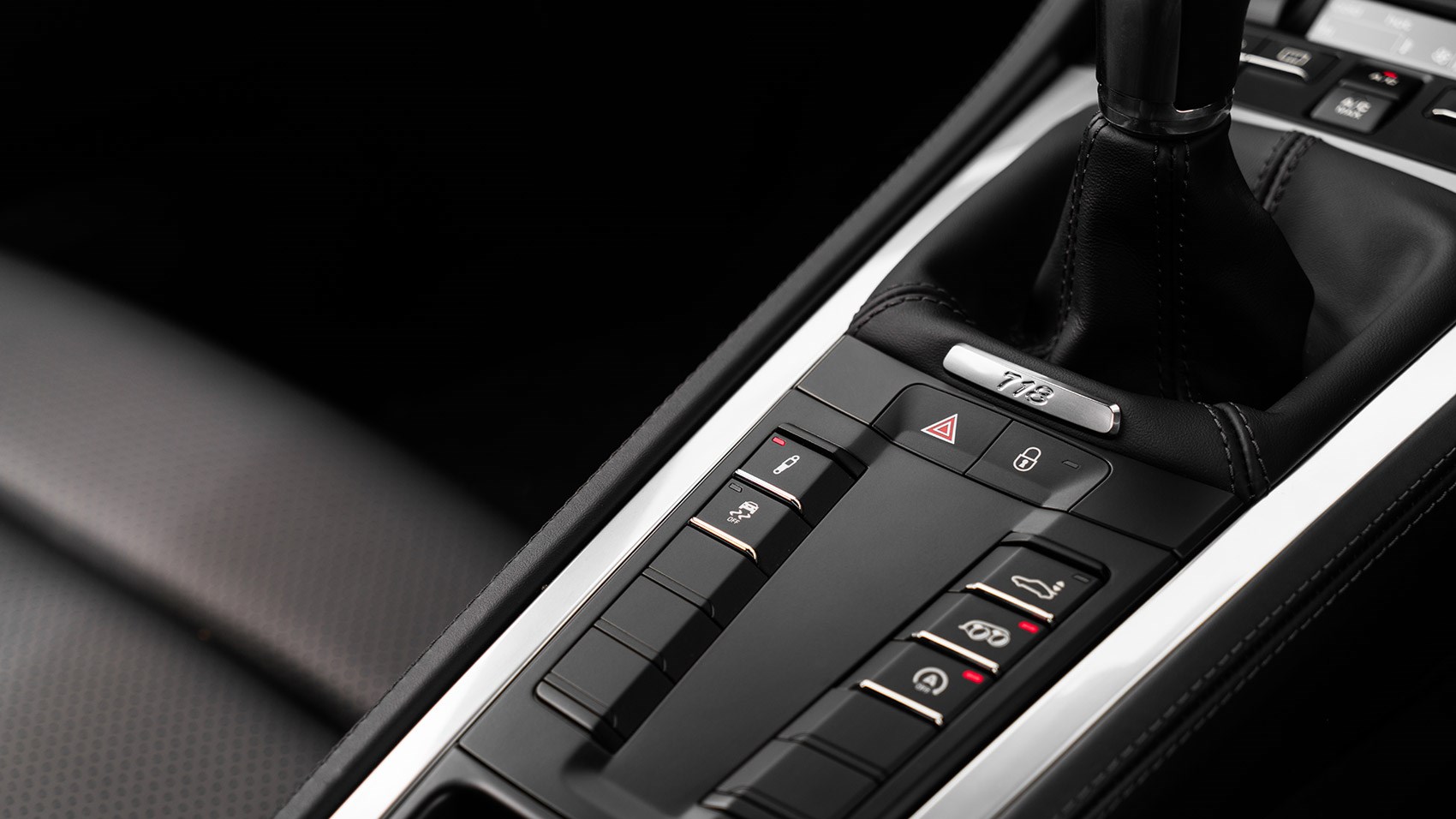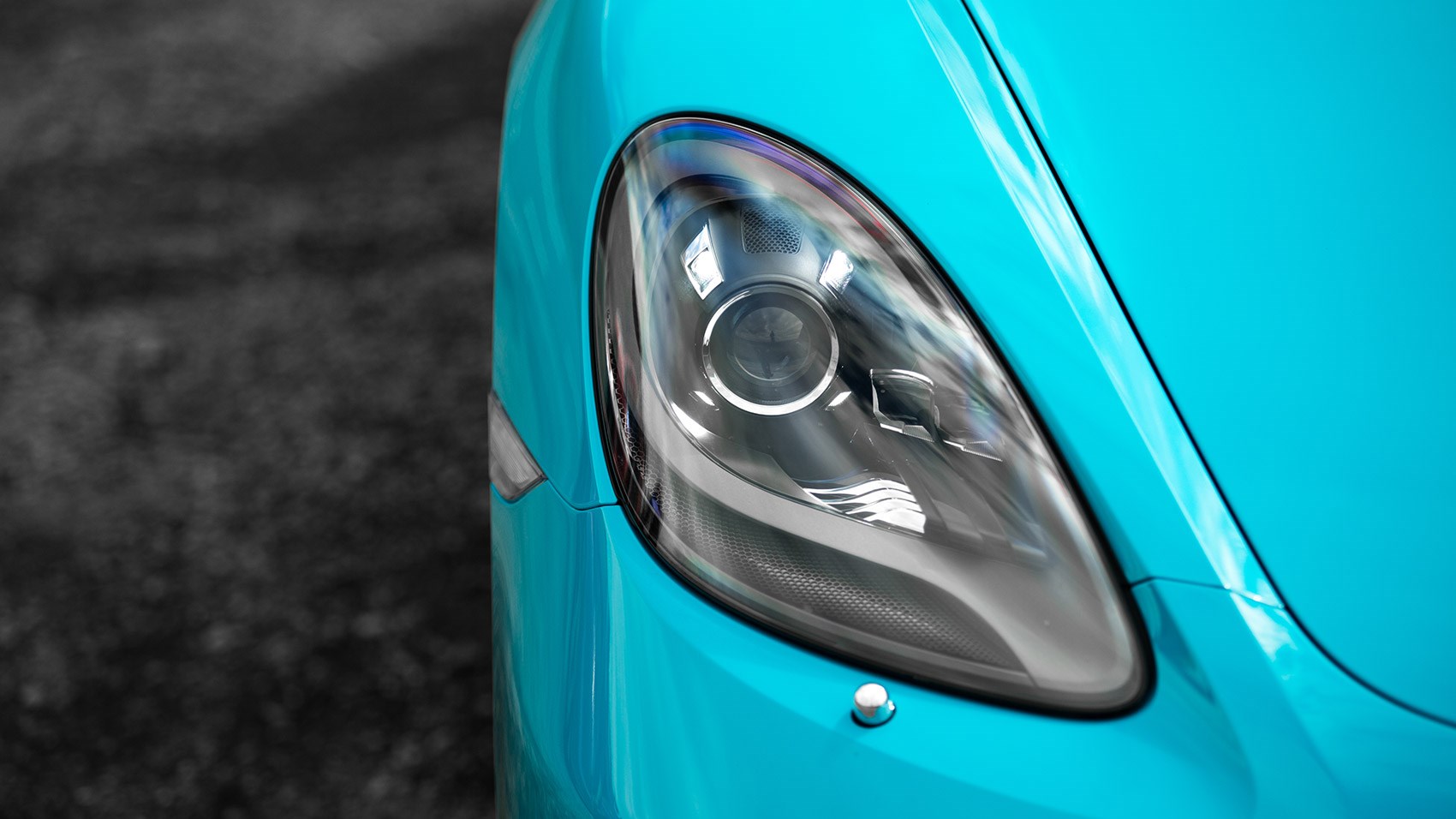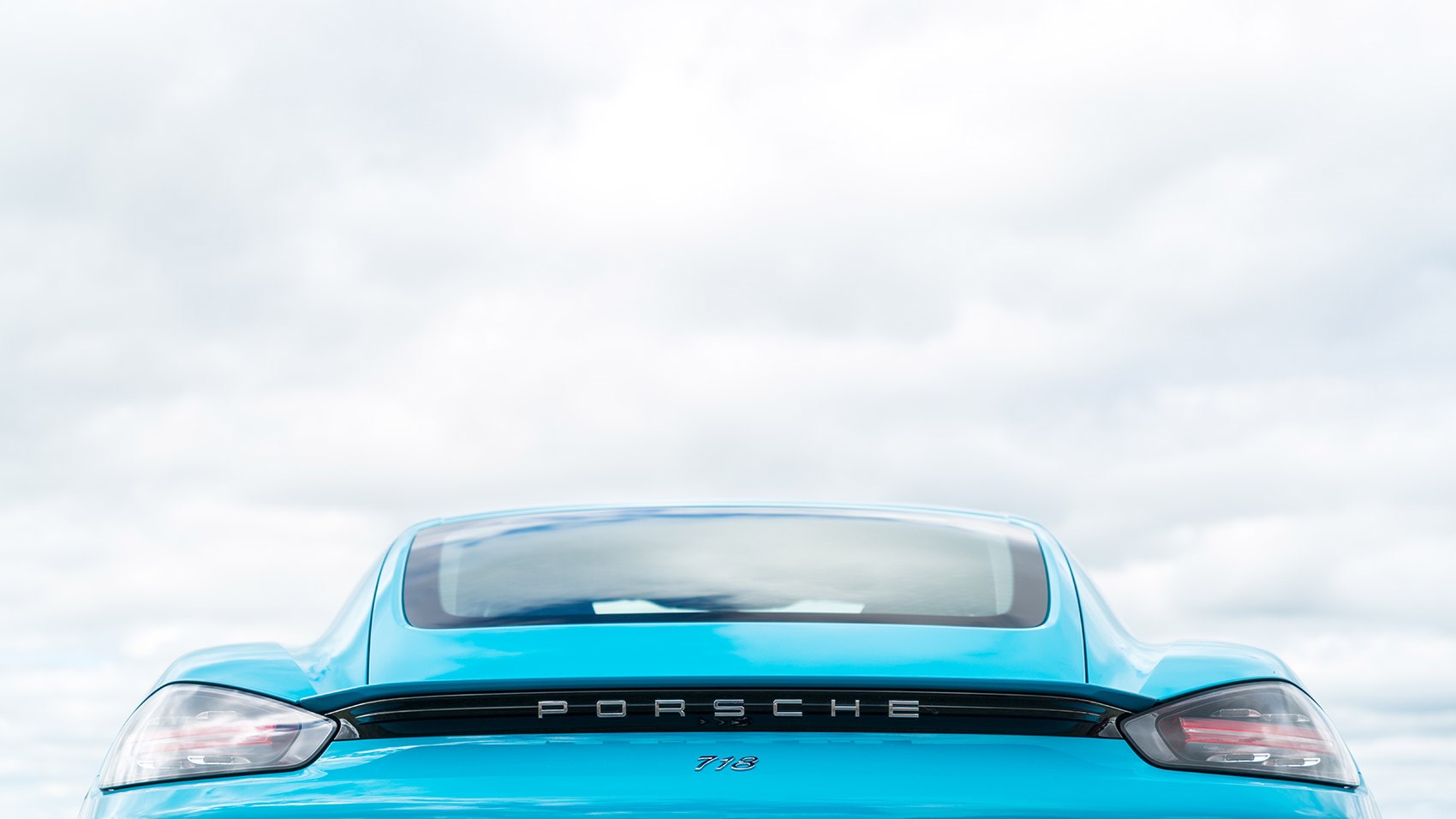► New turbocharged coupe driven
► UK Porsche 718 Cayman S review
► Brilliant, once you accept 4cyl turbo
Proof that the downsizing trend has well and truly arrived: even the good burghers of Zuffenhausen are ditching the company’s famous flat six for titchy turbocharged four-pots.
So far, this has only affected the newly fettled junior sports car range, renamed Porsche 718 Cayman and 718 Boxster. Big brother 911 continues with the horizontally opposed six-cylinder, although in the longer run we wouldn’t bet against a 4cyl version of that range too.
Here we test what has historically been our favourite sub-£50k sports car, the Cayman. Has downsizing ruined the 981.2 generation facelift? We’re about to find out in our UK review.
What’s new on the 2016 Porsche 718 Cayman S?
Stylistically, more of a nip-and-tuck. The lights are a fresh design, the mid-mounted engine air intakes are reprofiled to feed air to the hungry turbos and there’s a distinctive full-width Porsche badge between the taillamps. It’s comprehensively new, yet feels exactly the same.
The interior is tidied up too, with the latest Porsche Communication Management promising a serious upgrade to sat-nav and infotainment, while a 918-derived steering wheel adds a mode toggle to flick between Normal, Sport, Sport+ and Individual settings on the fly. It’s easier than flicking the myriad switches that still festoon the centre console, to the detriment of point-and-press ergonomics (you can’t see the heating controls when in the 1, 3 or 5 gears).
But the main change is behind the driver’s shoulder: out go the charismatic 2.9- and 3.4-litre flat sixes, replaced by a 2.0- or 2.5-litre horizontally opposed four-cylinder boxer engines.
In our 718 Cayman S spec, that means a single variable-vane turbocharger for 345bhp at 6500rpm and – a big change this – a 310lb ft torquefest, all the way from 1900-4500rpm. Remember those figures; they define how this car drives…
And that means what? A character bypass? Or running costs heaven?
There’s no escaping the purpose of this makeover. Porsche claims the smaller engine boosts economy, quoting a 34.9mpg thirst for fuel on the combined cycle. CO2 emissions shrink correspondingly to 184g/km.

We averaged an easy 33mpg on a long motorway cruise, but when the dual carriageway turns to a twisting blacktop, be warned: the turbo rams fuel and air into the 2497cc combustion chambers at quite a lick. On a harder charge, we slurped super unleaded in the low- to mid-20mpg zone during a blast criss-crossing rural Scotland, and a real thrash will push that down into the teens. You have been warned.
That lower emissions rating should cut costs for many drivers, however; company car tax stands at £269 a month for a lower-rate taxpayer and £537 for a higher-rate individual. Annual VED road tax comes to £230 after the first year.
Performance rated
There’s no getting away from this: the four-cylinder 2.5 is not as pleasing to the ear as the sonorous six that preceded it. At start-up there’s a clattery, Subaru-ish flat-four rumble and the noise is one that’ll take some getting used to. It’s not horrible, it’s just different for Porschephiles.
Higher up the rev range, it adopts a harder edge; there are shades of metallic rasp, hints of the horizontally opposed layout within the shriek it emits. But it’s remarkably subdued and it’s somehow less engaging, often washing away with the passing slipstream where the six made the hairs stand to attention on the back of your neck.
But golly does it fly. The new Porsche 718 Cayman S has considerably more muscle to call upon and performance feels brisk across the range. You’ll still need to spool the revs up past 3000rpm to get the coupe to really fly. Wring it to the 7400rpm redline and power continues to build in a pleasing manner alien to many blown engines.
How it feels
A change in character was inevitable when Porsche lopped off two cylinders. But the good news is the inherent rightness of the Cayman package remains intact. Porsche has nailed the touch points in its cars and the 718 feels just so, with all the controls exactly where you’d want them.

The driving position is brilliant, for starters. You climb in and sink down into well positioned seats. Visibility is first-class front and rear – this is a ludicrously easy car to drive, day-in, day-out. It’s one of our favourite daily driver sports cars for this reason.
Ours had the optional £2226 Sports Bucket Seats which fit slender frames snugly, but require some clambering into; we wouldn’t recommend them for chunkier builds. That grippy new steering wheel adjusts perfectly for reach and rake, while the pedals all have that beautifully engineered Porsche heft to them. It’s a consistent brand feel it somehow manages to replicate across its range, from coupes and convertibles to crossovers. Impressive.
Porsche 718 Cayman ride, handling
Prepare for superlatives. The 981.2 generation of Cayman has a sublime chassis. It’s been honed from the inherent sweetness of the first 987-era coupe and has matured into a nigh-on perfect handling package, in our view.
Our car was equipped with PASM adjustable dampers and 20mm lower Sports suspension (£1133) and rode on 20in Carrera Sport alloys (£1566). A stiff ride on big rims? Forget it. The 718 rides with a rare delicacy, though we rarely shifted into Sport on Britain’s crumbling black-top.
The car corners flat and true, and it’s willingly agile – the electrically assisted power steering is well judged, tipping the car keenly into corners, that mid-engined balance truer and easier to trust than the pendulum effect you can feel in extremis in a 911.

This Cayman S sported Porsche Ceramic Composite Brakes (surely a ludicrous option at £4977 – one for track-day geeks only) which provide unyielding stopping power, but we’d stick with regular steel rotors, were we ordering our own Cayman.
In short, there are few other cars at under £50,000 that we’d rather steer across our favourite moorside road. The 718 is that good, especially in Sport mode with the rev-matching downchanges making a hero of every blip-shift.
Interior, practicality
Okay, so you might want to save up for a 911 if you need occasional rear seats; the Cayman is restricted to two-pews only. But it’s highly practical for a car of this ilk, with that deep boot up front (150 litres) and a further 125 litres under the rear tailgate. Earlier iterations’ ‘trunk thunk’ has been banished, with no clatter from a loose-fitting bootlid.
A pair of classic Porsche cupholders sprout from the dashboard and there are the brand’s usual pop-out cubbies and pockets to house odds and sods. It’s all beautifully built and the latest Cayman’s leather dashboard really lifts the ambience, transforming the cabin from functional to junior supercar league special.
The new infotainment screen is miles better than what went before, too; it’s neat, easy to use and very responsive, combining some of parent firm VW’s hover-to-touch technology. It synced seamlessly with most modern smartphones we could throw at it, although it baulked at combining with a new Blackberry.
Other gripes? Our car’s manual shifter (neat, accurate throw, six speeds – none of the 911’s seven-speed confusion) obscures some of the heating controls and Porsche is still quite stingy with the standard equipment. No DAB radio in a car costing five times a boggo supermini which has it as standard? Come on…

Verdict
In case you hadn’t noticed, we love the new 718 Cayman here at CAR magazine. It’s a bit like Usain Bolt. Still brilliant and best in class – we just rue the passing of that super six-cylinder from yesteryear. We remember how much more sizzling Bolt was back at Beijing and London; but he was still at the top of the podium in Rio too.
Look out for the forthcoming flat sixes in the next instalment of the GT range. That’ll be quite a car… But so is the regular Cayman S. It’s still a five-star hero, despite the more sanitised engine.
Read more Porsche reviews